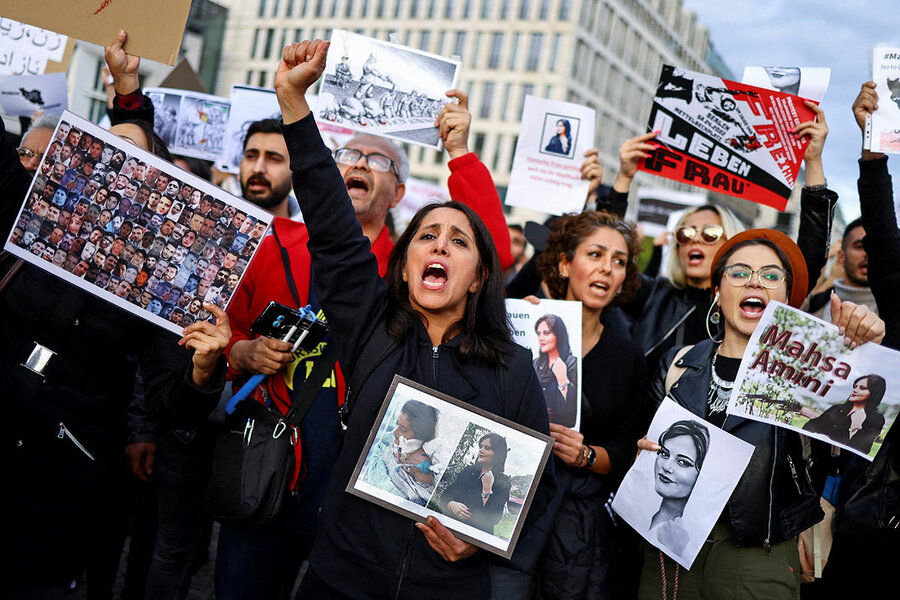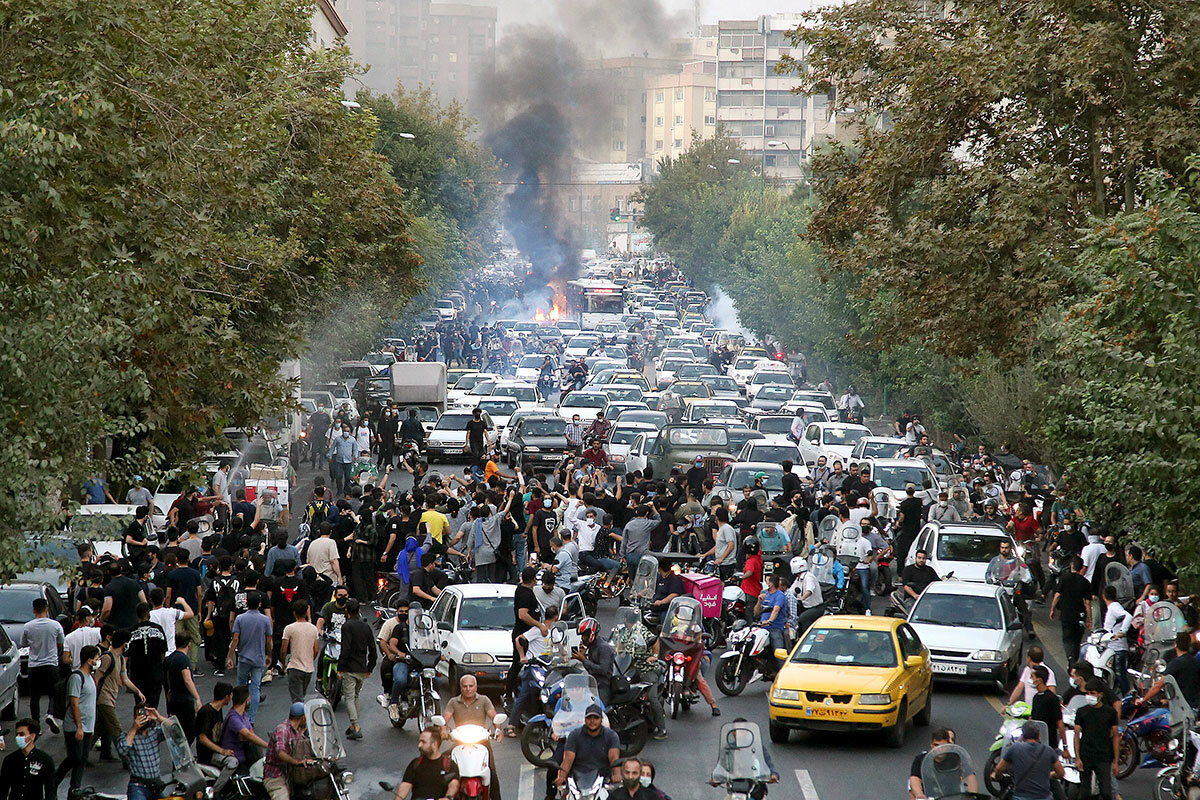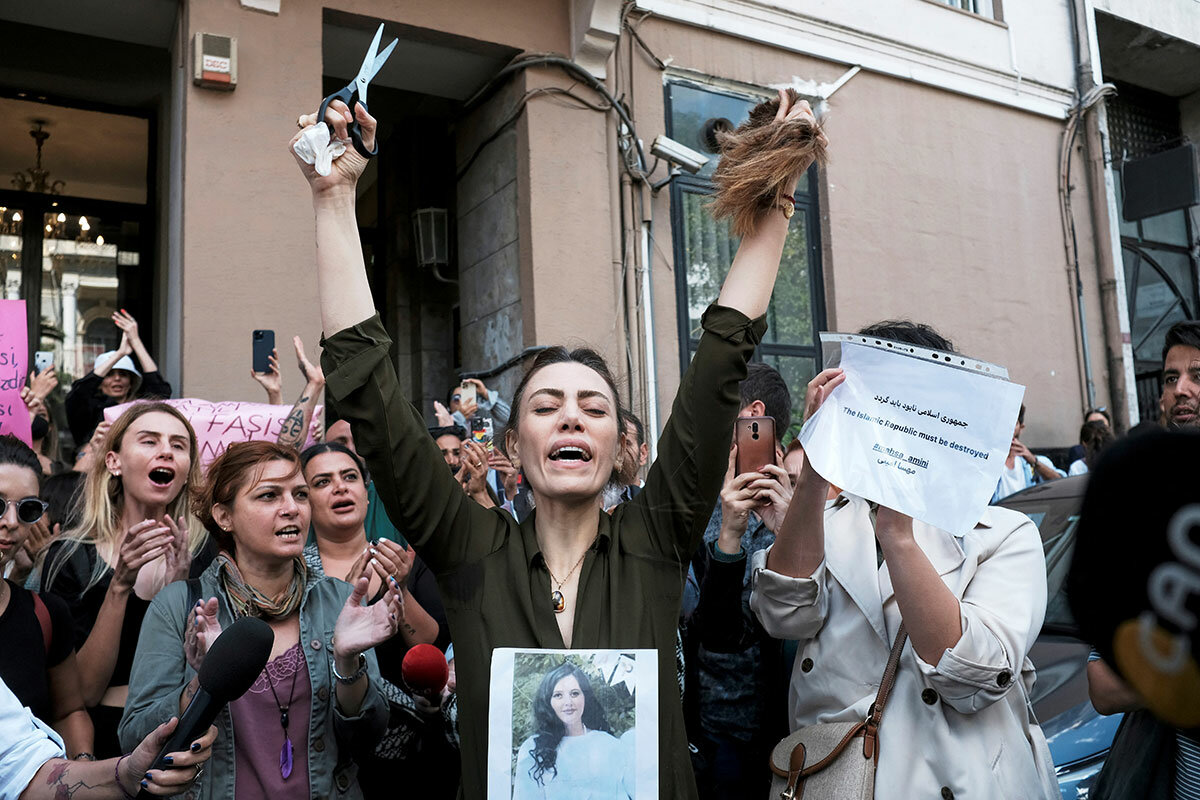‘This girl has united us all’: Women’s rage mobilizes Iranians
Loading...
| KHARKIV, Ukraine
Viewed from the level of Iran’s acrid, smoke-filled streets, the protests that have swept the country since the death a week ago of a young woman in the custody of the morality police have unleashed a pent-up determination to create real change in the Islamic Republic.
The protesters’ stated goals go beyond merely reforming the strict rules about women’s dress and extend to broadly expanding freedoms. And they speak openly of using violence to chip away at what they say is the calcified edifice of the regime.
Yet it is women’s outrage that is the driving force.
Why We Wrote This
A story focused onWomen and their freedoms are the catalyst for widespread demonstrations in Iran demanding reforms – even, as some protesters are saying, the toppling of the Islamic Republic.
Mahsa Amini was detained by Iran’s morality police for an alleged infraction of edicts that require the full covering of women’s hair with a hijab, or headscarf, in public. Witnesses and family members say the 22-year-old was severely beaten in custody, charges the authorities deny. Her death after a three-day coma triggered rage that quickly morphed into broader anti-regime unrest.
By Friday, protests had spread to some 83 cities, and the violent clashes and a crackdown by security forces have left 26 dead, according to state TV. Protesters say 50 have died.
Videos posted on social media appear to show police firing directly into crowds.
Women have conducted mass burnings of headscarves, and even symbolically cut off their own hair in protest, against a backdrop of burning police cars and buses, and clashes with baton-bristling riot police.
Indeed, women and the evisceration of their freedoms are for the first time since the Islamic Revolution of 1979 the catalyst for demonstrations demanding reform, even, as some on the streets are saying, the wholesale toppling of the regime.
“This is the moment I’ve been waiting for,” says Mahnaz, a 40-something English tutor in Sanandaj, a city in the Kurdish region of northwest Iran near Ms. Amini’s hometown, who has taken part in the protests. Like others interviewed, she gave only one name. Individuals in Iran were contacted by phone or online messaging services, despite severe disruptions to internet usage this week across the country.
“Our people have never been this united. Our men could never be more supportive of women,” Mahnaz says. “I know this might not necessarily lead to our ultimate goal of overthrowing the regime this time. But I have no doubt it’s causing a very deep crack on its body.
“It’s like a wall which you can’t smash to the ground with one blow. More blows, and it will collapse,” she says. “I am absolutely positive, victory is ours and it’s more imminent than it’s ever been.”
Shrinking political space
For years Iranians have reeled from a growing sense of hopelessness due to an economy crushed by U.S.-led sanctions, mismanagement, and corruption; political disenfranchisement; and more recently, even the failure to restore the 2015 nuclear deal with world powers.
Those problems have been exacerbated, analysts say, by conservative and hard-line control of all levers of power in Iran. Since President Ebrahim Raisi assumed office last year, the space for political expression has shrunk further.
In July the government rolled out a new hijab policy, and videos of morality police violently enforcing strict rules have gone viral.
On Thursday, during his first visit to the United Nations in New York, Mr. Raisi decried the “acts of chaos” in the streets of Iran.
“The Islamic Republic ignored us women, humiliated us, and destroyed two entire generations of women, and it only got worse,” says a protester in Sanandaj called Shiva, who’s 19 and plans to be a civil engineer.
“But they never knew that the rage was just intensifying beneath the surface. And guess what? We’re there to vent all that accumulated anger back into their faces. ... And trust me, it will be devastating,” she says.
“This girl [Ms. Amini] has united us all, because we could all relate to her, not just women, even men. She’s the embodiment of our plight; in one word she’s ‘Iran,’ its suffering, the barest form of a nation’s misery under a criminal regime,” Shiva says.
“Woman, life, freedom”
The protests have seen a welter of slogans, including “Death to the dictator” – a reference to Iran’s supreme leader, Ayatollah Ali Khamenei, whose portraits have been torn down and burned.
But there was also “Woman, life, freedom” – about the issue that sparked these protests, and a desire to open civil society.
According to Tara Sepehri Far, Iran researcher for Human Rights Watch, under Mr. Raisi Iran has been “trying to further curtail the very minimal space that activists were trying to create.”
“Labor rights activists, teachers, those were some of the leading voices in civil society that were organizing peaceful mobilization. They’ve been arrested; there’s been a crackdown against them,” says Ms. Sepehri Far. “There’s been a lot of human rights defenders [who] have been summoned to serve prison sentences.
“As a woman who grew up in Iran, seeing people united en masse for something that is about women’s choice of dress code, as well as obviously accountability for the death of Mahsa, it is unprecedented,” she says.
“I have never seen the criticism and calls for reform this loud. So regardless of where these protests go, the debate on hijab has moved forward forever, and there is no going back,” she adds. “Iranian women have demonstrated their will to walk in streets of big cities without hijab in total defiance of the law.”
Past nationwide protests have been brutally squelched, such as in 2009 over a presidential election widely seen as rigged, and in 2019 over economic grievances that are reported to have left 1,500 dead.
“No-violence idea is gone”
This time the anger seems to have leaped beyond class, economic, and ethnic boundaries that marked previous upheavals. Another change is the rejection by some of peaceful methods.
“This time the no-violence idea is gone. Even very young kids are sharing stuff [about] how to defeat the security forces,” says a businessman in southern Iran, who asked not to be identified further.
“In the past we wanted to be on the peaceful side and that was a value, but now it is the opposite,” he says. He points to a 19-year-old woman sharing tactics on social media of how to “take down” a squad of police officers on motorcycles.
Also making the rounds is a list of 13 techniques for countering interrogation, based on the past experience of detainees in Iran.
“Mahsa was a trigger,” says the businessman. “Establishment corruption is making everyone angry, but as I talk to very young friends, they are tired of being told what to do and not do,” he says. “They want to take down everything.”
“Those moments are behind us when they held rifles and we gave them flowers,” says Afshin, a student in Sanandaj.
Fueling popular anger is how the current government appears to have turned upside down 25 years of conventional political wisdom about maintaining peace in Iran. It holds that when the hard-line minority has the political upper hand, as it does today, social rules like hijab-wearing are slightly relaxed – in an unspoken quid pro quo over other policies unpopular with the majority, reform-minded population.
“It is quite clear that the government of Ebrahim Raisi has to give something back to the ultraconservative elements of the system that have elevated him to this position, and in these circles the mandatory hijab is obviously a very sensitive and very elementary issue,” says Adnan Tabatabai, an Iran expert and founder of the Bonn, Germany-based Center for Applied Research and Partnership With the Orient.
At the same time, he says, there may now be “a critical mass of political figures that may be pushing for gradual changes in how the mandatory hijab is enforced.”
“Probably it is not anxiety that the system and the elite feel, because they’re all aware that they have the necessary zeal and the necessary means to suppress these kinds protests and clear the streets in the coming days and weeks,” says Mr. Tabatabai. “But we at least have some current and former officials who have been extremely critical of mandatory hijab and its enforcement, who spoke out long before the case of Mahsa Amini, and have spoken out again.”
Two sisters
Any change won’t come soon enough for two sisters in Kermanshah, a provincial capital in northwest Iran. Each hold master’s degrees, and both were peaceful attendees at rallies. One night last week one was arrested, when 30 security agents descended on their home at 3 a.m.
“I couldn’t believe my eyes,” says one sister, who reckons her sibling was identified by security cameras. “You can’t believe how wild they were in the raid, cursing with the worst-ever sexist slurs, dragging her on the floor.
“If you remember, once they were propagating the slogan that if we don’t fight Islamic State in Syria, we have to battle it in our streets,” she says.
“Now they are ISIS loud and clear, and they have no shame to act like it. So aren’t we fighting an enemy right on our own soil?” she asks. “They are occupiers; it’s high time we pushed them out.”
An Iranian researcher contributed reporting for this story.








